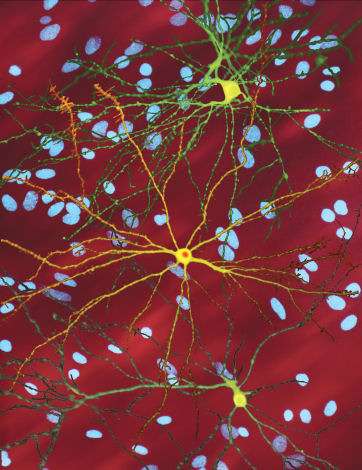Discovery could aid in development of treatments for fatal brain disease

Huntington's disease is an inherited brain disorder that is uniformly fatal, but researchers at Johns Hopkins believe they have made a big discovery about how the disease progresses that could lead to a way to stop it.
Their findings offer hope for a treatment to more than 30,000 Americans who have Huntington's symptoms and another 200,000 at risk of inheriting the disease. They also could help scientists better understand other fatal brain diseases such as amyotrophic lateral sclerosis and a certain type of dementia, as well as help researchers learn more about normal brain aging.
"We found these kind of traffic jams in cells, and if we can fix the traffic jams we can potentially provide a new avenue for treatment of neurodegenerative disease," said Jonathan Grima, a graduate student in the Johns Hopkins University School of Medicine department of neuroscience whose research was published this week in the journal Neuron.
Grima said it's not clear if a drug developed to clear these jams could stop cells from dying, and thus stop progression of Huntington's, but that is the goal. Grima works in the lab of Dr. Jeffrey Rothstein, director of Hopkins' Brain Science Institute.
Rothstein, who normally focuses on ALS, also known as Lou Gehrig's disease, has pursued similar cell research for that disease and a drug that may offer some treatment is being investigated. He said the lab is in the early stages of working on its own drug for Huntington's.
Rothstein said he expects other scientists to build on the findings about Huntington's disease in the search for a treatment.
The Huntington's researchers, including scientists from other departments at Hopkins, as well as the University of Florida and the University of California, Irvine, have demonstrated how Huntington's disease disrupts normal cell activity, Rothstein said.
Components of a brain cell, such as salts and proteins, need to move in and out of a cell's operations center, the nucleus, to keep it functioning properly. In people with Huntington's disease, proteins produced by the Huntington's-related gene clump together in the nucleus and can't pass through special passageways called nuclear pores - every cell has many of these pores - causing the cells to shut down and die.
While scientists have known there was a Huntington's gene and knew about nuclear pores, they hadn't been closely studied in the brain. They didn't know about this clumping and clogging of the pores and breakdown in so-called nuclear transport in Huntington's sufferers, Rothstein said.
The discovery was met with intense interest by Huntington's researchers.
"This is very exciting research because we didn't know what mutant genes or proteins were doing in the body, and this points to new areas to target research," said George Yohrling, senior director of mission and scientific affairs at the Huntington's Disease Society of America. "Scientists, biotech companies and pharmaceutical companies could capitalize on this and maybe develop therapies for this biological process."
Yohrling said there are only two treatments now for Huntington's disease, one just approved in recent weeks by the U.S. Food and Drug Administration. They both help ease gait and movement problems that are associated with the disease. Other drugs are used to treat depression and anxiety that also normally accompany a Huntington's diagnosis.
But there is nothing to stop or slow the progression of the disease, which causes sufferers to lose the ability to reason, speak and walk over a 10- to 25-year period, according to the Huntington's Disease Society. Symptoms usually appear at age 30 to 50 and sufferers have a 50-50 chance of passing the disease on to their children.
For the Huntington's research, the scientists used mice as well as human stem cells and human tissue to test their research ideas. Research findings in rodents, typically used as stand-ins for humans, frequently disappoint researchers when they try to reproduce the work in humans. But since this research also involved cells and tissue from humans, Yohrling noted, scientists are more confident in the findings.
For all the optimism about the research - and Yohrling said there was plenty in the Huntington's research community - he cautioned that the work is early. It's still not clear if a drug to protect cells would ameliorate symptoms in humans, or how much or for how long it would slow or stop the disease.
The Hopkins researchers and other scientists echoed those warnings.
An effective treatment for Huntington's likely will require a cocktail of drugs to control symptoms and stall disease progression, said Charbel Moussa, director of the Translational Neurotherapeutics Program at Georgetown University Medical Center.
That's because the disease is complex and scientist don't understand all of the affects that Huntington's has on the brain and why some areas of the brain are unaffected, he said. The new findings nonetheless give researchers a leg up in their search for effective drugs.
"This significantly expands our understanding of Huntington's disease pathology, and the pathology of diseases that are similar to Huntington's disease, and even what we see in aging," Moussa said. "We're still, unfortunately, far from a cure."
©2017 The Baltimore Sun
Distributed by Tribune Content Agency, LLC.
















